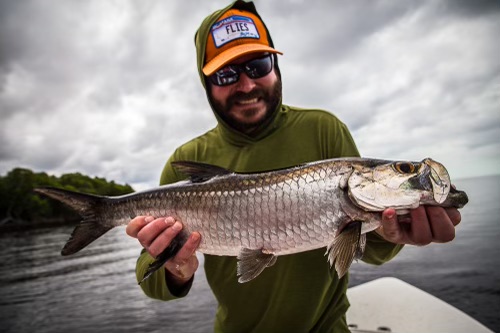
Photo Credit - Kyle Zempel of Black Earth Angling Co.
The first cold weather of November has settled into the Northern Hemisphere. For many anglers, this signifies the kick-off of the winter saltwater season. When traveling to the salt for what could turn into the trip of a lifetime, I can't stress enough the importance of being appropriately outfitted. Due to the remoteness of many destinations, it's impossible to get something you didn't bring along, and, oftentimes it's the little things that can make the trip go from a 7 to a 10. Read on for a list of gear that will ensure you make the most of your trip.
This might be the easiest part of the packing list. There are plenty of rod and reel options dedicated to saltwater. Having a rod and reel suited for the demanding conditions can make the difference between success and failure when you need to make that critical cast. Plus true saltwater tackle is resistant to the damaging effects of the salinity in the water and air. Plain and simple, salt destroys gear. Having a rod with an aluminum or synthetic reel seat and a reel with a fully-sealed drag is ideal. And, if it's in cards, have backup rods and reels in case disaster strikes. After your fishing day, be sure to thoroughly rinse your rod and reel with fresh water to avoid any corrosion.
Cover up! Everyone from colder climes love fishing in the tropics during the winter. Warm sun feels great, especially if you haven't seen it in weeks, but this can quickly turn into too much of a good thing. Fortunately there are great clothing options to protect you from the elements on your trip.
What you have on your feet can be extremely important in the salt, particularly in wade fishing situations. If you're buying your first set of wading boots for the flats, go directly to a Flats Boot. They are supportive, abrasion resistant and have a non-marring rubber sole formulated for grip on coral. Many flats are riddled with sharp urchins, crabs, coral and other things that can tear up your feet. Combine the boots with a pair of guard socks. These neoprene wading socks come with a built-in gravel guard and help keep sand and marl out of your boots. If you know that you're going to be wading some areas that have hard sand, a pair of wading booties are a nice addition to Flats Boots.
When fishing from a boat, your footwear can make a big difference, too. Many anglers like to go barefoot on the deck of a skiff so they can feel the fly line when it makes its way under a foot. This option is great until it's rough. Something I've noticed over the years is that balancing on the deck of a boat in rough water works muscles in your feet that you don't use very often. It can be nice to have footwear that provides some support and a stable platform. Flats boots work, but can get a little hot when you're not in the water. I prefer a shoe, like the Simms Challenger Air Vent, to provide some stability and not cook my feet.
You just can't beat fully waterproof gear on the boat or when wade fishing. It's another defensive barrier against the corrosive effects of salt water and salty air. I use a waterproof sling pack when wading which doubles as a great boat bag. Most waterproof slings have enough room for a few fly boxes, all your terminal tackle, a light rain jacket and a spare beverage, or two. If you're primarily fishing out of a boat, a waterproof boat bag is the answer. You can keep all your gear in one place and don't have to worry about rain or boat spray.
Good polarized shades are critical when fishing the salt. They can be the difference between seeing the fish, or not. Polarized brown or copper lenses are the best tints for shallow flats. It's a good idea to bring a spare pair in case you lose or break your go-to glasses.
If you're traveling outside the U.S. on your trip, assume your destination will not have any line, leaders or tippet...even if they say they do. These small items become worth their weight in gold when you need them. Have plenty of leaders and tippet to get you by. Also bring spare fly lines. Flats fishing can be very tough on lines. I once had a running bonefish wrap a line around an exposed piece of coral. I could see the coating of the line peeling off as the fish bolted! That was on day one of an eight day trip. If I didn't have spare lines, I would have been in serious trouble.
This tiny item is absolutely critical. Regardless of the age of your line, one day of fishing will leave it feeling a bit on the sticky side. After giving your gear a freshwater rinse, take the time to clean and dress your line. It makes a huge difference. Flies- Similarly just assume that you can't get any flies where you're going. Load up before you depart. Have multiples of likely performers. As long as they don't get wet, they won't go bad. High quality flies also make for a nice addition to your cash gratuity for guides in remote destinations. Self-Care Items- Bring plenty of sunscreen, SPF lip balm and aloe in case you get too much sun.